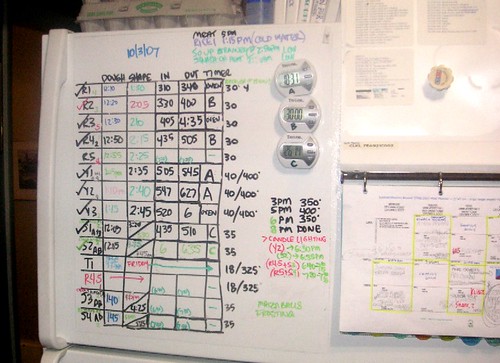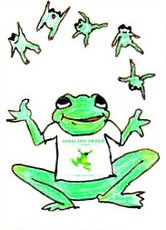Don't worry. I'm not about to start revealing unpleasant personal medical information. I've started vermicomposting.
It's usually at this point, after I explain that I've voluntarily brought thousands of worms into my kitchen, that people start to back away, slowly, surreptitiously seeking the most direct path to the nearest exit.
You see, it's a bit of a stretch for a Jewish housewife to bring worms *into* the kitchen. Jewish dietary laws forbid ingesting worms, and the kosher cook is required to spend significant energy obsessing about inspecting produce for worms (and other bugs).
So I'd like to make it clear: We don't put the worms in our food. We put our food into the worms.

Adventures in Vermicomposting: Tales of the wet and squiggly.
It was a short but wiggly path to worm ownership. I'd read about it for a while and was intrigued by the idea of odorless composting indoors in the Winter; tantalized by the prospect of goof-proof fertilizer. Worm castings make excellent fertilizer that doesn't burn plants.
The "worm box" can be made almost arbitrarily small, and kept in the kitchen, basement, or an outdoor container (insulated when exposed to frost, and heated in extreme temperatures).
The only thing holding me back from full worm custodianship was that I was too cheap reticent to pay for the earthworms.
I mean, after all, we have a yard. We have a lazy and neglected compost pile. After every rainfall, earthworms sun themselves in our driveway. Pay for earthworms? You've got to be kidding! Or so I thought.
One day, about a month ago, as I sat at my computer, casually Googling "homemade vermiculture systems", I decided to start first, and figure out the particulars along the way.
From my desk, I called out to my son, who had the misfortune of being home at the time, "Jonathan! JONATHAN!!"
"Yes, Mommy?"
"Are you wearing shoes?"
"No." A sudden wariness curled the edges of his voice. After a beat, slowly and carefully, he offered, "I could put them on."
"Good. Please put on yucky shoes and go collect a bunch of earthworms from the yard."
"Huh?"
"You know, earthworms. I think 100 will be enough to start."
"But it's raining!"
"Exactly! That's the best time to collect them. They come out in the rain."
"No way. "
"What do you mean, 'no way'?! I'm your mother, and I want earthworms. Go get me some."
"Sorry."
"Didn't you hear me? I really mean it. I want you to dig up a bunch of earthworms for me. The sooner you get started, the sooner we can begin. I have a really cool project to do, and this is part of it."
"Look Mommy, it's not going to happen. I'm not going to go - out in the rain - get all wet and dirty - to dig up some disgusting worms. And I want nothing to do with any project that requires worms, or getting wet, or anything like that. "
"Look, Jonathan. You are my son, and I am your mother. The whole point of having a son, is that when you want earthworms, it's his job to go and dig them up. This is your job. "
"Nope. Not going to happen."
"Jonathan! The mother doesn't get her own earthworms. That's just not right. Please. Go. Get. Me. Some. Worms."
"Sorry. You're on your own." And with that, he retreated, barefoot and dry, to his room to do something useless and boring like study for a chemistry test.
Channeling The Little Red Hen and muttering under my breath something about "ben sorer u'moreh"*, I donned a pair of rubber gloves and set out to dig up a starter colony of earthworms.
Finding and capturing the worms was more difficult than I expected.
Our compost pile is mostly yard waste, piled high and left unturned for the eight years we've owned the house. The result is a cylinder of fantastic soil, ten feet in diameter, piled higher than me, without odors or pests. It has tons of earthworms and what I now recognized (thanks to the Internet) as worm cocoons.
The problem was, more often than not, they squiggled away from my wet grasp. The rain helped uncover them, but it also helped them escape.
Four hours later, drenched to the core and covered in mud, I declared victory and left the battlefield with my bounty: a mason jar of about fifty worms. "Discretion is the better part of valor", after all.

Jar of earthworms from our garden. There are about 50 worms inside.I tried not to dwell on how much better my son would have been at this than I was. I would have mentioned it to him, but he was hiding in his room. The coward.
I made a mesh lid for the jar using of a bit of window screen and set it, covered with a towel, on the kitchen counter. (I had read they prefer the dark.) Peeling off wet clothes , I considered burning my sneakers, then went to wash up and figure out what to do next.
Searching on-line for worm box instructions, I learned I had collected the wrong sort. The kind I had, the regular garden earthworm, is great for plants. Its castings make fine soil. But they are not appropriate for indoor vermiculture because they burrow and don't do well indoors in containers.
The type of earthworm most suitable for indoor composting is the Red Wiggler. It's a top-feeder, making the compost easy to harvest. It's also a very hungry worm, processing half its body weight every day. So, two pounds of red wigglers eat seven pounds of kitchen scraps a week.
 A half gallon of kitchen scraps (peelings, coffee grinds, eggshells, etc.) weighs about 2.5 pounds.
A half gallon of kitchen scraps (peelings, coffee grinds, eggshells, etc.) weighs about 2.5 pounds.Also, Red Wiggler worms tend to be quite happy in containers and seldom escape.
After reluctantly releasing my worms in our strawberry patch, I headed off to find a reasonable source of Red Wigglers. The pet store was less than helpful. I spent a bit of time looking for a bait shop, but it was getting late.
For some reason, the more I was thwarted in my attempts to acquire the worms, the stronger my determination became. (There's a word for this, but I'm pretending not to know what it is.)
 Our strawberry "patch" lives in an old plastic pool. It was cracked and couldn't hold water any longer, making it perfect for a well-drained planter.
Our strawberry "patch" lives in an old plastic pool. It was cracked and couldn't hold water any longer, making it perfect for a well-drained planter.So. Off I went to Wal-Mart. The nearest one was 20 miles away. I got there, just as the doors were closing, and ran to the back of the store. I found the small glass-fronted refrigerator in the fishing section. It was almost empty, save for three small plastic pints of worms. Unfortunately, they were Night Crawlers. Not Red Wigglers. No amount of reading and rereading the containers changed their names. I left empty handed. The clerk had to unlock the door to let me out of the store.
During the half-hour drive home, I realized that I'd spent half a day and eight dollars' worth of gas and still remained wormless. It was time to cut my losses and order the stupid worms on-line.
Before midnight, I placed an on-line order with the
Worm Ladies of Charleston**, and fell asleep.
The next morning, it seemed a good idea to clean out my refrigerator in order to begin collecting kitchen scraps to feed to the worms when they arrived. This way, the scraps could begin to rot a bit in advance preparation for our guests. The worms eat the rot on the fruit or vegetable, not the fruit or vegetable itself. I wanted to get a head start so I could start feeding them as soon as possible after I got them.
Looking into my refrigerator, I noticed just how much of its contents were not food. There were the bundled asparagus roots I ordered before learning they wouldn't do well in a container. They were waiting for me to locate and dig out a sunny 20-foot plot to plant them. There was the bottle of kosher vegetable rennet, awaiting a cheese-making experiment, based on a blog
post at Kosherblog. There was a chilled
aluminium rolling pin, a container of home-made play dough, and a trivet covered in candle wax that was put there to make it easier to clean.
And there, all the way in the back, was a plastic bag filled with mushroom spores. I had forgotten all about the mushroom spores.
They came with
the mushroom growing kit I bought a couple of months ago. The kit came with four varieties of mushroom spores: three logs that could be grown indoors (Shiitake, Oyster, and Pom Pom Blanc) and one (Morel) that required its own dedicated outdoor compost heap. The instructions said the Morel spores can be kept refrigerated until their habitat is established and ready for them.
 These are the mushroom spores, from the back of my refrigerator.
These are the mushroom spores, from the back of my refrigerator.It seemed a good day to deal with the mushroom spores. Part of why I had procrastinated about setting up the Morel Mushroom Habitat was that I was a bit spooked from reading about the
horrible deaths experienced by those poisoned by eating False Morels. While the kit guarantees the safe, good, real kind of Morels, I am still a bit squeamish at the prospect of eating unbounded mushrooms popping up in unpredictable locations.
I've never had a Morel mushroom, but those I've asked who have had them, say that they really are "all that".
Figuring "if not now, when?", I set up a large container, dubbed it "Mount Morel", and filled it with the best soil from the compost heap. And, what does a compost heap need? Earthworms, of course!
And that is how, I came to spend another half day, digging up earthworms. Fourteen hours after I let their cousins free in the strawberry patch, I spent the morning under the greedy eyes of the flock of doves*** that live in our yard, harvesting the pile for worms to populate Mount Morel.
 This is the very large old plastic container I used to house the Morel Mushroom Habitat.
This is the very large old plastic container I used to house the Morel Mushroom Habitat.  This is the same box, after cleaning it and painting it.
This is the same box, after cleaning it and painting it. When the paint was dry, I drilled a bunch of holes in the bottom for drainage.
When the paint was dry, I drilled a bunch of holes in the bottom for drainage. Mount Morel, near our back fence. The surface is about 9 square feet of soil. I put about 8" of rich compost in the bottom of the container, then crumbled the mushroom spores on top, mixing them in about 4" deep. Then I covered it with another 4" of soil.
Mount Morel, near our back fence. The surface is about 9 square feet of soil. I put about 8" of rich compost in the bottom of the container, then crumbled the mushroom spores on top, mixing them in about 4" deep. Then I covered it with another 4" of soil. Kitchen scraps (peelings, egg shells, coffee grounds, but no animal products or fats) leaves from indoor plants, and weeds from the garden got turned into the top layer and covered up with more soil.
Kitchen scraps (peelings, egg shells, coffee grounds, but no animal products or fats) leaves from indoor plants, and weeds from the garden got turned into the top layer and covered up with more soil. Every few days, I turn under more of the same materials.
Every few days, I turn under more of the same materials.My worm delivery arrived a couple of days later. So, I'm now the happy guardian of two sets of worm colonies. We have a discreet box of happy and productive Red Wigglers in the kitchen, and another population thriving in the protected shady backyard enclave of Mount Morel.
 The box from the Worm Ladies is meant to be used as is. It comes with a bunch of holes already drilled in it. But, I wanted to add a few more to keep the system well aired out. The reason garbage cans smell bad, is that they are closed up, and work anerobically (without oxygen).
The box from the Worm Ladies is meant to be used as is. It comes with a bunch of holes already drilled in it. But, I wanted to add a few more to keep the system well aired out. The reason garbage cans smell bad, is that they are closed up, and work anerobically (without oxygen).
I made more air holes to help keep the box from smelling bad. Then, (maybe a bit paranoid, but it made me feel better to do this) I duct-taped bits of window screen to the inside of the box, over every air hole. Call it the Wormy Hotel California: They can check out any time they like, but they can never leave. The kit I bought from The Worm Ladies came with "coir", which is shredded coconut. It makes an excellent bedding material for the vermiculture system. It retains moisture very well.
The kit I bought from The Worm Ladies came with "coir", which is shredded coconut. It makes an excellent bedding material for the vermiculture system. It retains moisture very well.
The coir arrived in a compressed brick form. To set it up, I soaked it in water, strained it, and put it damp (but not leaking wet) in the bottom of the prepared worm container. Two pounds of worms were shipped in a lunch-sized wax-lined paper bag. They were a mixture of tiny baby white ones and mature adult red worms.
Two pounds of worms were shipped in a lunch-sized wax-lined paper bag. They were a mixture of tiny baby white ones and mature adult red worms. I added a handful of beach sand (for grit) and shredded newspaper and junk mail (for bedding and humidity control.) The worms don't have teeth, so they need a bit of grit to aid their digestion.
I added a handful of beach sand (for grit) and shredded newspaper and junk mail (for bedding and humidity control.) The worms don't have teeth, so they need a bit of grit to aid their digestion. The worms took to their new home very well, immediately burrowing under the bedding.
The worms took to their new home very well, immediately burrowing under the bedding. Kitchen scraps are placed on top of the worms and bedding, then covered with more bedding.
Kitchen scraps are placed on top of the worms and bedding, then covered with more bedding. A bunch of shredded newspaper as the top layer, helps stabilize the humidity in the box and prevents flies from landing on the food scraps.
A bunch of shredded newspaper as the top layer, helps stabilize the humidity in the box and prevents flies from landing on the food scraps. Our worm box sits on a cart, so it can be wheeled up to the counter to receive scraps.
Our worm box sits on a cart, so it can be wheeled up to the counter to receive scraps. Gretta is our resident vermicomposting evangelist, explaining to all who will listen:
Gretta is our resident vermicomposting evangelist, explaining to all who will listen: "Worms eat garbage. They make dirt. They don't have teeth, so they don't bite you. You have to hold them carefully or they will get squished. They poop and the poop makes the plants grow a lot. Some people think they're yucky or scary but we like them."
This was a lot of fun, and we've been at it for a month now. But, if I ever have to dig up another worm again, it will be too soon.
=====
* (
Devarim/Deuteronomy 21:18-21)
** After some shopping around on-line, I chose them because they were nearby, reasonably priced, and enthusiastic. Plus I liked
their story and their style.
*** I had to cover the box with chicken wire to keep the birds from eating all the worms in the box. I felt like Elmer Fudd, shaking my fist in the air at them, calling out "Stupid birds! Go get your
own worms. These are MINE."




 Thread the ribbons through the floss threader's loop.
Thread the ribbons through the floss threader's loop.


 Tuck the long end of the tail into the space between the cover and the book's pages. I use a cake tester or barbecue skewer to help push the tail and keep it from bunching up.
Tuck the long end of the tail into the space between the cover and the book's pages. I use a cake tester or barbecue skewer to help push the tail and keep it from bunching up.








































